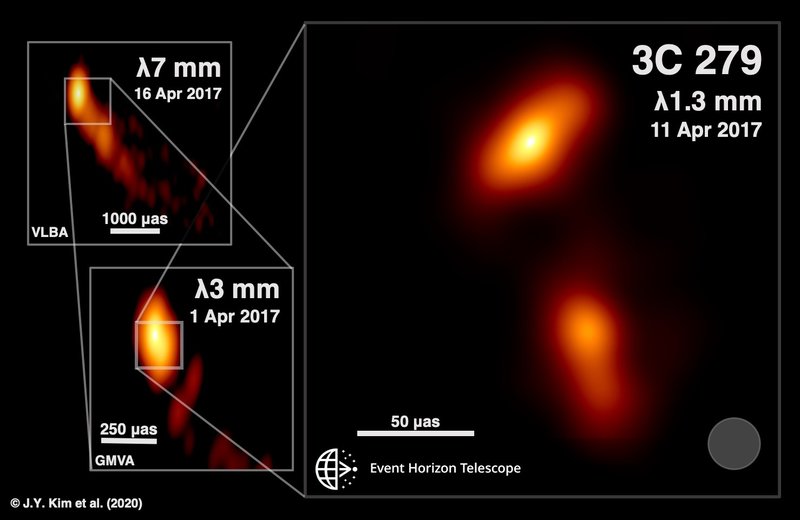Event Horizon Telescope spots weird black-hole jet mystery inside quasar
At the same time the Event Horizon Telescope was gathering data to create the first-ever image of a black hole, it was also observing an even stranger object.
That object was a quasar, a pair of jets full of super-fast material shooting out from near a supermassive black hole. And the Event Horizon Telescope data suggested that those jets aren't working the way scientists had expected them to, with confusing kinks at their base.
"We knew that every time you open a new window to the universe you can find something new," Jae-Young Kim, an astronomer at the Max Planck Institute for Radio Astronomy in Germany who led the new research, said in a statement from the institute. "Here, where we expected to find the region where the jet forms by going to the sharpest image possible, we find a kind of perpendicular structure. This is like finding a very different shape by opening the smallest Matryoshka doll."
Related: Eureka! Scientists photograph a black hole for the 1st time
The quasar is known as 3C 279 and is located 5 billion light-years away from Earth. Astronomers identified the object as a quasar because of an incredibly bright point of light at its center. That point seems to mark jets of particles where the black hole — which contains about the mass of a billion suns — is spitting out material that it can't quite capture.
The Event Horizon Telescope studied the object over four days in April 2017. And the collaboration could study these jets at a resolution of less than one light-year. (A light-year is the distance light travels in a year, about 6 trillion miles or 9.7 trillion kilometers.) That detail let astronomers on the new research analyze small details within the jets near their source. The scientists thought these jets would begin as they continued, as straight beams.
But what the team found was unexpected. According to this new view, at its base, a jet is a twisted structure that changes from day to day. The researchers don't yet know how any of this occurs, although they think it could have something to do with how the jets meet the accretion disk surrounding the black hole.
Breaking space news, the latest updates on rocket launches, skywatching events and more!
Scientists involved in the research also think that the jet's strange structure could help explain why the material in the jet appears to be moving toward us at a whopping 20 times the speed of light, a complex optical illusion.
Like the groundbreaking black hole image published last year, the new research relies on the Event Horizon Telescope's data-intense technique to turn a global array of instruments into one massive, Earth-size telescope. In 2017, eight observatories took part in the project; by next summer that number should be 11. The more facilities take part, the sharper the Event Horizon Telescope's results become.
"The EHT array is always improving," Shep Doeleman, founding director of the Event Horizon Telescope and an astronomer at the Harvard-Smithsonian Center for Astronomy, said in a statement released by the EHT consortium. "These new quasar results demonstrate that the unique EHT capabilities can address a wide range of science questions, which will only grow as we continue to add new telescopes to the array."
However, the COVID-19 pandemic closed observatories within the network and forced the Event Horizon Telescope to cancel its annual observing campaign for 2020. Scientists affiliated with the project will spend this year focused on further analyzing the 2017 data that included these quasar results, as well as beginning to analyze data gathered in 2018.
The research is described in a paper published today (April 7) in the journal Astronomy and Astrophysics.
- All your questions about the new black hole image answered
- 'Infinite subrings' may be next frontier for photographing black holes
- Why is the first-ever black hole photo an orange ring?
Email Meghan Bartels at mbartels@space.com or follow her @meghanbartels. Follow us on Twitter @Spacedotcom and on Facebook.
OFFER: Save 45% on 'All About Space' 'How it Works' and 'All About History'!
For a limited time, you can take out a digital subscription to any of our best-selling science magazines for just $2.38 per month, or 45% off the standard price for the first three months.

Meghan is a senior writer at Space.com and has more than five years' experience as a science journalist based in New York City. She joined Space.com in July 2018, with previous writing published in outlets including Newsweek and Audubon. Meghan earned an MA in science journalism from New York University and a BA in classics from Georgetown University, and in her free time she enjoys reading and visiting museums. Follow her on Twitter at @meghanbartels.


